
The double-lined mackerel, is a species of Spanish mackerel in the family Scombridae. This species is sometimes also called the scad mackerel.
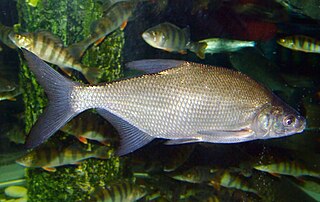
The common bream, freshwater bream, bream, bronze bream, or carp bream, is a European species of freshwater fish in the family Cyprinidae. It is now considered to be the only species in the genus Abramis.
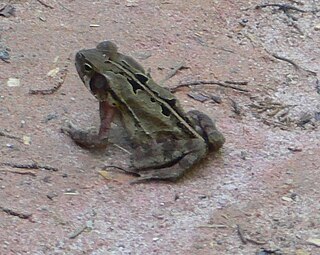
Rhinella crucifer is a species of toad in the family Bufonidae. It endemic to Brazil and known from the Atlantic Forest of eastern Brazil between the states of Ceará in the north and Rio de Janeiro in the south. Common name striped toad has been coined for it. "Rhinella pombali" is a hybrid between Rhinella ornata and this species.

Mimetes arboreus, or Kogelberg pagoda, is an evergreen, upright large shrub or small tree of 2–6 m (6½–20 ft) high in the family Proteaceae. It grows from a thick trunk with a smooth grey bark that branches at ½–1 m (1½–3 ft) above the ground. It has silvery, lance-shaped, pointy leaves of 5–8¼ cm (2.0–3.3 in) long and ¾–3¼ cm (0.3–1.3 in) wide, at an upward angle and overlapping each other. The inflorescences are set just below the top of the branches, are cylinder-shaped, 8–10 cm in diameter, topped by a crest of more or less horizontal pinkish or reddish tinged leaves. It consists of several flower heads in the axils of pinkish orange leaves that form a hood shielding the underlying flower head. Each flower head contains eight to thirteen individual flowers, with bright red styles and grey silky perianth lobes. It is endemic to the Fynbos ecoregion of South Africa, being confined to the Kogelberg mountain range.

Calamotropha is a genus of moths of the family Crambidae.
Calamotropha aureliellus is a species of moth in the family Crambidae. It is found in France, Switzerland, Austria, Italy, Germany, Poland, the Czech Republic, Slovakia, Hungary, Romania, Bulgaria, the Republic of Macedonia, Greece, the Russian Far East and Japan.
Calamotropha fuscilineatellus is a species of moth in the family Crambidae. It was described by Daniel Lucas in 1938 and is found in Portugal, on Sardinia and in Morocco.

Calamotropha hierichuntica is a species of moth in the family Crambidae described by Philipp Christoph Zeller in 1867. It is found in Greece, Israel, Jordan and Syria.

Crambus hamella is a species of moth in the family Crambidae described by Carl Peter Thunberg in 1788. It is found in most of Europe, east to the Russian Far East and Japan. It is also found in North America, including Alberta, Arizona, Manitoba, Michigan, Oklahoma and Ontario.
Calamotropha anticella is a moth in the family Crambidae. It was described by Francis Walker in 1866. It is found in South Africa and Sri Lanka.
Calamotropha fulvifusalis is a moth in the family Crambidae. It was described by George Hampson in 1900. It is found in Amur and Ussuri in the Russian Far East and Honshu and Hokkaido in Japan.
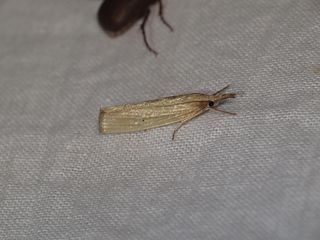
Calamotropha leptogrammellus, the grass webworm, is a moth in the family Crambidae. It was described by Edward Meyrick in 1879. It is found in Australia, where it has been recorded from Western Australia, the Northern Territory, Queensland, New South Wales and Victoria.
Calamotropha melanosticta is a moth in the family Crambidae. It was described by George Hampson in 1896. It is found in Sri Lanka.
Calamotropha oculalis is a moth in the family Crambidae. It was described by Samuel Constantinus Snellen van Vollenhoven in 1893. It is found on Java and Sri Lanka.
Ambia fulvicolor is a moth in the family Crambidae. It was described by George Hampson in 1917 and it is found in New Guinea.

Serruria fasciflora or common pin spiderhead is a species of flowering plant in the family Proteaceae. It is a sprawling to upright shrublet of 40 cm to 1 m high and about 1⁄2 m wide. It has finely divided, upward curving leaves with thread-thin segments and clusters of sweetly scented heads, each consisting of five to seven silvery pink flowers, that may be found year-round, but mostly from May to December. It is a rather widespread and common species, that is restricted to the south of the Western Cape province of South Africa.

Leucospermum wittebergense is an evergreen, upright to more or less spreading shrub of ½–1½ m (1⅔–5 ft) high and wide from the family Proteaceae. It has globe-shaped flower heads of about 2 cm (0.8 in) in diameter with initially whitish, later pinkish flowers. It has crowded, overlapping, inverted lance-shaped leaves, set at an upward angle and covered in short, dense grey-silvery shaggy hairs. From the center of the perianth emerge almost straight styles that jointly give the impression of a pincushion. It is called Swartberg pincushion in English. The species naturally occurs in the Western Cape province of South Africa. It can be found flowering between August and January.
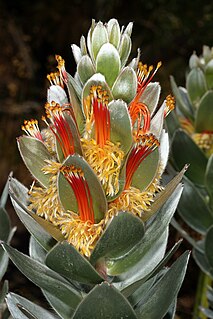
Mimetes hottentoticus is an evergreen, upright shrub of 1½–3 m (5–10 ft) high from the family Proteaceae. It has silvery, broadly egg-shaped to egg-shaped leaves with three small teeth crowded at the tip. The flower heads and subtending leaves form a cylindric inflorescence, topped with a tuft of smaller, more or less upright silvery or pinkish leaves. Each flowerhead contains 8–12 flowers with conspicuously red styles, that are all parallel, projected straight up, pushing against the leaf subtending the higher flowerhead. The styles end in a short white zone topped by a thick blackish pollen presenter. Flowers can usually be found from January till March, few may persist into May. It is called silver pagoda or matchstick pagoda in English and Hottentotstompie in Afrikaans.

Mimetes splendidus or splendid pagoda is an evergreen, rather sparsely branching, upright shrub of up to 2½ m (8 ft) high from the family Proteaceae. It has broadly lance-shaped to oval, silvery-hairy leaves with three or four teeth crowded at the tip. It has cylinder-shaped inflorescences that consists of many heads, each containing eleven to thirteen flowers, in the axils of the highest leaves. These leaves form a hood over a lower flowerhead and are flushed orangy pink. It flowers during winter, from early May to September. It is an endemic species that is restricted to the south face of the coastal mountains of the Western Cape province of South Africa.
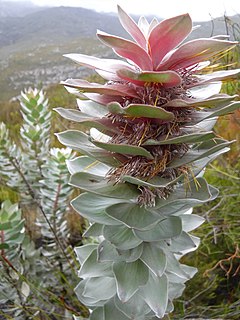
Mimetes argenteus is an evergreen, upright, hardly branching, large shrub of about 2 m high in the family Proteaceae. It has elliptic, silvery leaves, due to a dense covering of silky hairs, that stand out a right angle from the branches. It has cylindric inflorescences of 8–15 cm (3–6 in) long and 10–12 cm (4–5 in) in diameter, crested by smaller silvery pink leaves at an upright angle. These consist of many flower heads, each containing six to nine individual flowers and ar set in the axil of a leaf flushed mauve to carmine. It flowers from March to June. The silver pagoda naturally occurs in the Western Cape province of South Africa. It is called silver pagoda or silver-leaved bottlebrush in English and vaalstompie in Afrikaans.











